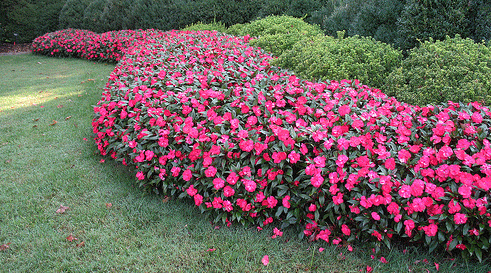Impatiens should be called the “shiekh of the shade garden.” Along with coleus, they’re one of the most adaptable flowers for those areas under trees and the like that don’t get much sun. In fact, it is best to keep them out of full sun, if possible, where they will “wither thusly,” to speak in Shakespearean terms.
Planted in a mass or cluster they will attract the eye to those areas of the lawn where deep shadows abide. People often plant them under the canopies of trees. Impatiens are easy to care for and will bloom all summer, so you definitely get your money’s worth out of this one.
When to Plant Impatiens

Plant impatiens in the spring time after all danger of frost has passed.
Where to Plant Impatiens
For best results plant in rich, moist, well-drained soil in light to full shade.
Planting Depth for Impatiens
Impatiens are bedding plants. They are normally sold in cell packs and should be planted to the depth they grew in the cell pack. Simply bury the root ball it is growing in since there is no need to break the root ball apart before planting.
Spacing of Impatiens
Space impatiens about 4-6 inches apart.
Planting Impatiens
[/vc_column_text][/vc_column][/vc_row]
Digging the planting hole:

Step 1
Use the metal adapter plates provided to set the desired depth of the hole, from 2″, 4″ or 6″ deep holes. Select the adapter plate which corresponds to the size of the cell in which your impatiens were sold. For most common sized cells, you’ll likely use either the 2″ or 4″ adapter.
Step 2
(Step, twist & pull) Step down on the foot pegs until the adapter plate bottoms out against the soil. Give the 5-IN-1 a slight twist to break the plug of soil free and pull up on the handle bars. There! You’ve just dug your planting hole. If a larger diameter hole is needed, take several “bites” with the 5-IN-1 until you’ve created the desired size (see video for demonstration).
Plant the Impatiens
Remove the impatiens from its’ growing cell and place into planting hole. Use amended soil to fill in around the impatiens, pressing down gently. Remember to water well after planting.
Feeding Impatiens
If grown in fairly rich soil, impatiens will require only a light feeding of an all purpose fertilizer right after planting. Mulching around the plants with aged compost or well rotted manure will achieve the same effect as a light feeding of fertilizer.
Disease and Pest Problems
Impatiens are susceptible to powdery mildew, a disease that is currently spreading in some greenhouses across the country. The disease causes the leaves and stems to turn a milky white. Purchase healthy plants from a reputable garden center. Preventative measure like proper spacing and good air circulation are key for keeping powdery mildew and other fungus diseases at bay. In hot and humid areas where the condition is likely to develop, the application of fungicides is suggested. Captan or a copper based fungicide such as Soap Shield from Gardens Alive may be helpful to apply before you see signs of the disease.
Be sure to check out the helpful information on our website, including other uses for the ProPlugger including:
Neil Moran is a horticulturist and author of three books on gardening. He is also the creator and author of the garden blog North Country Gardener

